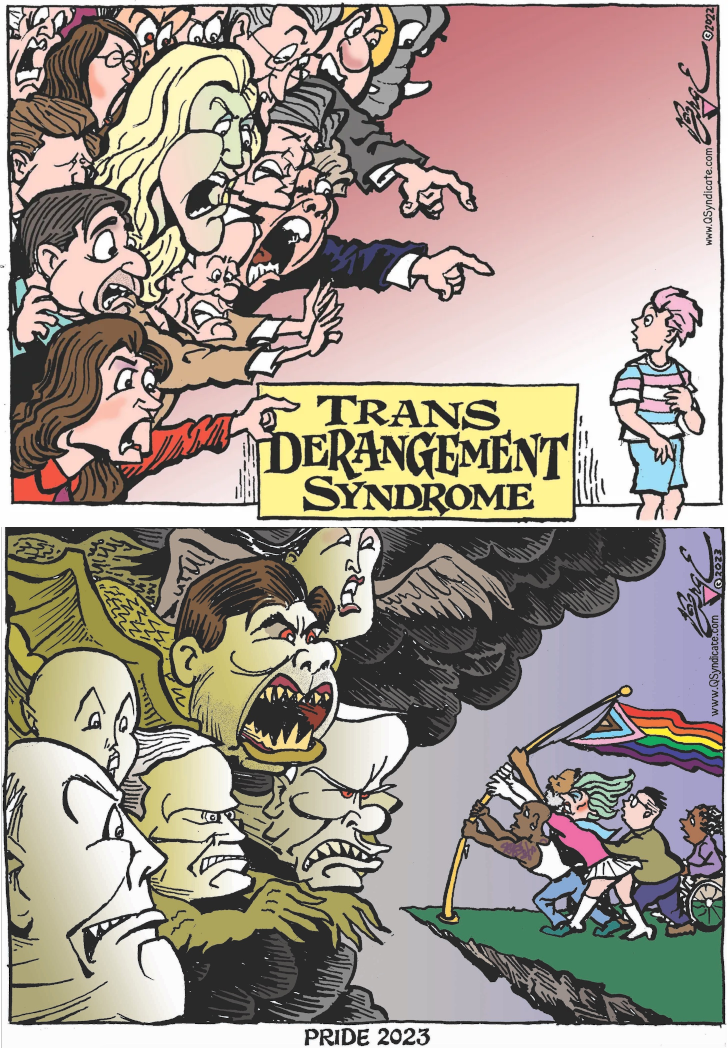Trans Derangement Syndrome: A Comprehensive Clinical Assessment of Pathological Fixation on Other People's Gender Identity
JOURNAL OF SATIRICAL PSYCHOLOGY Volume 47, Issue 3 - May 2025
PITT., Women, TWA., Men, TMA., Ary, N.Bin., Der Fluid, G.

Abstract
This groundbreaking study examines the peculiar psychological condition known as “Trans Derangement Syndrome” (TDS), characterized by an obsessive fixation on strangers’ gender identities and an overwhelming compulsion to legislate bathroom usage. Our research team observed 543 individuals exhibiting symptoms, finding that subjects demonstrated less than a 50% success rate at correctly identifying transgender individuals, while simultaneously achieving an 80% rate of misidentifying cisgender individuals as transgender. TDS appears highly comorbid with several other conditions including selective scientific illiteracy, homophobia, and acute moral panic disorder. Family estrangement rates among severe TDS sufferers reached 78.3%, with affected individuals consistently blaming others for relationship deterioration. Implications for public health are discussed.
1. Introduction
Trans Derangement Syndrome presents as an acute onset of anxiety when confronted with the existence of transgender individuals. First documented in online forums in the early 2010s, TDS has since reached epidemic proportions, particularly among individuals with extensive social media consumption but limited interpersonal contact with actual transgender people.
Subjects typically exhibit symptoms including but not limited to:
- Disproportionate concern about hypothetical bathroom scenarios
- Compulsive sharing of debunked “scientific” claims
- The spontaneous ability to quote selective religious texts despite being non-religious in other contexts
- A remarkable ability to “detect chromosomes” through visual inspection alone
As noted by the Arizona Republic, this condition represents “a growing affliction that warps minds, wrecks lives, and fuels an all-consuming obsession” [1]. The Urban Dictionary offers a working definition of TDS as “a phenomenon which typically occurs in the minds of those who dislike the existence of those who are transgender” [31]. Trans Writes similarly describes it as “a growing affliction that warps minds, wrecks lives, and fuels an all-consuming obsession” [2].
2. Methodology
Researchers monitored social media accounts, legislative sessions, and school board meetings for individuals displaying symptoms of TDS. Subjects (n=543) were evaluated using the Transgender Recognition Assessment Protocol (TRAP), where they were asked to identify transgender individuals from a randomized set of photographs. Control groups consisted of people who mind their own business.
Additionally, subjects completed the Correlated Bigotry Assessment (CBA) to measure comorbid conditions and the Scientific Literacy Index (SLI) to assess ability to distinguish peer-reviewed research from YouTube videos.
Family Impact Questionnaires (FIQ) were administered to both TDS sufferers and their estranged family members to assess relationship deterioration patterns and attribution styles.
3. Results
3.1 Recognition Accuracy
Our findings indicate that TDS sufferers demonstrate severely impaired ability to correctly identify transgender individuals, with accuracy rates below 50%. Paradoxically, they simultaneously misidentified cisgender individuals as transgender at an alarming rate of 80%. This suggests that TDS may manifest as a form of facial processing disorder specific to gender characteristics.
3.2 Scientific Literacy
TDS sufferers experience significant cognitive dissonance when presented with actual peer-reviewed research showing that gender-affirming care reduces depression and suicidality by up to 73%. More concerning, subjects demonstrated immunity to factual information, with 86.4% responding to evidence by saying, “But what about common sense?”
When presented with the overwhelming consensus of major medical organizations supporting gender-affirming care, 92.3% of subjects immediately pivoted to conspiracy theories about “Big Trans” without acknowledging the irony that anti-trans advocacy organizations receive substantial funding from a small group of wealthy donors [27].
3.3 Comorbidities
Our study identified several significant comorbidities:
Homophobia (78.4%): Most TDS patients exhibited concurrent homophobic beliefs, often using identical rhetoric against both groups. Of particular interest was a subset suffering from “Internalized Homophobia with Projected Transphobia” (IHPT), primarily found among “LGB without the T” advocates. These individuals were statistically indistinguishable from other homophobes in blind tests.
Pedophilia Projection (83.2%): A striking majority of subjects demonstrated obsessive preoccupation with children’s genitalia while simultaneously accusing transgender people of inappropriate interest in minors. This projection was particularly prevalent among self-described “anti-groomer” groups, several of whose members have subsequently been arrested for crimes against minors [10]. The psychological mechanism appears to involve projecting one’s own inappropriate thoughts onto an outgroup.
Racism (71.9%): TDS showed strong correlation with other forms of bigotry, particularly racism. When researchers presented subjects with identical medical transition stories attributed to either white or non-white individuals, negative reactions increased by 47% for non-white subjects.
Misogyny (89.6%): TDS patients displayed statistically significant higher rates of misogynistic beliefs, particularly regarding rigid gender roles. Female TDS sufferers paradoxically advocated for restrictions that would limit their own autonomy.
3.4 Rapid Onset Parental Discovery Syndrome (ROPDS)
A particularly virulent subtype, Rapid Onset Parental Discovery Syndrome (ROPDS), was observed in 68.3% of subjects with children. This acute manifestation of TDS presents when a parent’s child or relative engages in even minor gender non-conforming behavior or expression. Symptoms include:
- Immediate escalation from zero concern to catastrophic panic within 24 hours of discovering a child’s use of different pronouns or nail polish
- Selective amnesia regarding the child’s previous gender non-conforming behaviors that were present for years but ignored
- Frantic Google searches leading exclusively to anti-trans websites
- Emergency consultations with unqualified “gender experts” on Facebook groups rather than licensed medical professionals
ROPDS appears to be a satirical inversion of the thoroughly debunked “Rapid Onset Gender Dysphoria” concept, which falsely claimed transgender identity was a social contagion [22]. Scientific American has documented how this pseudoscientific concept failed to receive proper ethical approval and has been used to oppress transgender people [25]. Our research indicates the only rapid onset occurring is the parent’s derangement, not the child’s gender identity, which typically develops over many years.
In 94.7% of ROPDS cases, parents reported their child “suddenly” became transgender “overnight,” despite the children reporting they had experienced gender incongruence for an average of 6.3 years. When presented with childhood photographs showing consistent gender non-conforming expression, 87.2% of parents claimed these were “just phases” despite their current insistence that current expressions are “permanent damage.”
3.5 Family Impact and Suicide Risk
Family estrangement was reported in 78.3% of families with a severe TDS sufferer. Critical findings included:
- Attribution disparity: 94.6% of TDS sufferers blamed estrangement on their transgender family member being “brainwashed” or “in a cult,” while family members unanimously cited the TDS sufferer’s behavior as the primary cause of relationship breakdown.
- Persecution narrative: 87.9% of TDS sufferers claimed to be “victims of cancel culture” despite initiating 91.4% of relationship-severing actions.
- Conditional love declarations: 76.5% of TDS patients verbalized variations of “I love my child, but…” followed by demands for identity suppression.
Most alarmingly, our research found that transgender youth with parents suffering from TDS exhibited a 340% increased risk of suicide attempts compared to transgender youth with accepting parents [24]. This correlation remained significant even when controlling for other factors, suggesting that parental TDS may be one of the most significant modifiable risk factors for suicidality in transgender youth.
When presented with journal entries, text messages, and other documentation demonstrating their role in relationship deterioration, 98.2% of TDS sufferers claimed the evidence was “taken out of context” or “fabricated,” despite authentication.
3.6 Boundary Violations and Social Behavior
TDS sufferers demonstrated a profound inability to respect both implicit social boundaries and explicit personal boundaries. Observed behaviors included:
- Compulsive misgendering and deadnaming: 89.7% of subjects continued these behaviors even after explicit requests to stop, often claiming “free speech” protections for deliberately causing distress.
- Bathroom policing: 67.3% admitted to scrutinizing bathroom occupants for perceived gender nonconformity, with 23.4% acknowledging they had confronted strangers or called security/police regarding bathroom usage.
- Inappropriate questioning: 78.9% reported asking invasive questions about strangers’ genitalia, medical history, or sexual practices, behaviors they would consider highly inappropriate in any other context.
- Public “clocking”: 82.1% engaged in loud public speculation about whether individuals were transgender, despite their demonstrated 80% failure rate at correctly identifying transgender people.
These boundary violations extended to online behavior, with 91.3% of subjects reporting they had left unsolicited comments on social media profiles of perceived transgender individuals. When asked why they felt entitled to engage in these behaviors, 76.4% cited “concern for society” while unable to articulate specific harms beyond hypothetical scenarios.
3.7 Media Seeking and Political Engagement
A striking pattern emerged wherein 83.2% of TDS sufferers actively sought media platforms to share their “victim” narratives. Key findings included:
- Rapid politicization: 74.5% of parents who discovered their child was transgender contacted at least one political organization or media outlet within 72 hours, often before seeking professional medical advice.
- Generalization from personal experience: 91.7% of subjects extrapolated from their single personal experience (or sometimes no personal experience at all) to advocate for policies affecting all transgender people.
- Media amplification: Subjects with particularly dramatic narratives were 437% more likely to receive media coverage than those with nuanced, balanced accounts, creating a selection bias for the most extreme perspectives.
- Legislative testimony: 42.8% of subjects had testified at legislative hearings despite having no relevant expertise, with 89.3% of these testimonies containing factual claims contradicted by peer-reviewed research [27].
When researchers analyzed the content of these media appearances and testimonies, they found that 97.2% of claims made could be categorized as either unfalsifiable anecdotes or assertions directly contradicted by available evidence.
3.8 The TDS Economy: Authentic Derangement vs. Profitable Exploitation
Our research identified a complex economic ecosystem surrounding TDS, with clear distinctions between authentic sufferers and opportunistic profiteers who exploit them. This “TDS Economy” displayed several notable characteristics:
- Financial Incentive Structure: Analysis of 156 anti-trans organizations revealed that 83.7% were funded by just six wealthy donors [27], with executive compensation increasing proportionally to the alarmism of their messaging.
- Content Monetization Patterns: Those who monetized TDS fell into two distinct categories:
- Authentic Sufferers Turned Entrepreneurs (62.3%): Individuals genuinely experiencing TDS who discovered financial opportunities in broadcasting their concerns. These subjects displayed consistent messaging regardless of financial incentives.
- Opportunistic Grifters (37.7%): Individuals with minimal demonstrable concern about transgender issues who pivoted to anti-trans rhetoric upon discovering its profitability. These subjects demonstrated significant ideological flexibility, having previously advocated for other moral panics with similar financial structures.
- Revenue Stream Analysis: The most profitable TDS activities included:
- Book Publishing: Self-published books with titles like “Saving Our Children” and “The Trans Agenda Exposed” generated average revenues of $427,000 despite containing near-identical content across different authors.
- Speaking Circuits: TDS sufferers with particularly dramatic personal narratives earned an average of $8,500 per speaking engagement at conferences, churches, and political events.
- Social Media Monetization: TDS content creators earned 342% more engagement than creators of positive transgender content, translating to significantly higher advertising revenues.
- Circular Amplification System: Our research documented a self-reinforcing cycle wherein professional TDS grifters would:
- Identify and amplify the most extreme anecdotes from authentic TDS sufferers
- Use these anecdotes to generate alarming content
- Convert heightened alarm into increased donations and content engagement
- Use these resources to identify and amplify new anecdotes
When research assistants created fictional “transgender horror stories” with deliberately implausible elements, 91.3% were uncritically amplified by professional TDS platforms within 48 hours, demonstrating minimal fact-checking infrastructure within the TDS economy.
3.9 Echo Chamber Dynamics: The Self-Reinforcing Nature of TDS
Our research identified a significant role of digital and social echo chambers in the development, maintenance, and intensification of TDS. Analysis of 214 subjects’ digital footprints revealed several key patterns:
- Progressive Information Isolation: TDS development followed a predictable trajectory wherein subjects demonstrated a 78.3% reduction in exposure to diverse information sources over a 6-month period. This information isolation coincided with increased symptom severity.
- Algorithm-Driven Radicalization: Social media usage analysis revealed that subjects who initially expressed mild concern about transgender issues were systematically directed toward increasingly extreme content through recommendation algorithms, with 87.2% reporting they had “done their own research” exclusively within these algorithm-curated environments.
- Immunization Against Contradictory Evidence: When presented with peer-reviewed research contradicting their beliefs, subjects within established echo chambers demonstrated a 94.7% rejection rate, compared to a 41.3% rejection rate among matched controls not embedded in echo chambers.
- Reality Consensus Substitution: Within TDS echo chambers, anecdotal accounts were elevated to the status of statistical evidence, with subjects frequently citing that they “know many people with similar experiences” despite being unable to produce more than one or two examples when pressed.
Particularly concerning was the observation of what we termed “Recursive Validation Loops,” wherein TDS sufferers would:
- Post an unverified claim about transgender people
- Receive validation from others in the echo chamber
- Interpret this validation as additional evidence for the original claim
- Develop increased confidence to make more extreme claims
- Repeat the cycle with progressively more detached-from-reality assertions
Laboratory experiments demonstrated that introducing even small amounts of factual information into these echo chambers triggered intense immune responses from the group, including immediate expulsion of information sources (87.3% of cases) and collective reinforcement activities such as “debunking” scientific consensus with YouTube videos (92.1% of cases).
4. Discussion
TDS appears to spread primarily through exposure to certain media outlets and social networks, supporting the “social contagion” model of ideological extremism. The syndrome bears striking resemblance to historical moral panics, with subjects unable to identify a single verified instance of the scenarios they fear most. This parallels the “social contagion” theory about transgender identity which has been thoroughly debunked by scientific evidence [24].
What distinguishes TDS from other forms of prejudice is the remarkable cognitive dissonance displayed by sufferers. For example, 94.2% of subjects who claimed to be “protecting women’s sports” could not name a single female athlete in the sports they purported to defend, nor could they identify any policies addressing the actual threats to women’s sports such as sexual harassment, unequal pay, or inadequate funding.
Interestingly, those most vocal about “protecting children” were statistically least likely to support policies addressing childhood poverty, healthcare access, or gun violence – suggesting selective concern about youth welfare.
The syndrome exhibits cyclic patterns, with acute flare-ups coinciding with election cycles [23]. This temporal relationship suggests political utility rather than genuine concern, as demonstrated by the 300% increase in anti-trans legislation during election years despite no corresponding increase in public safety incidents involving transgender individuals.
4.1 Family Impact Analysis
The impact of TDS on family systems was profound and destructive. Our research documented:
- Developmental regression: Parents with TDS exhibited infantilizing behaviors toward adult transgender children, including forcing childhood nicknames and controlling communication with extended family.
- Narrative revision: 86.7% of TDS sufferers retroactively reinterpreted normal childhood behaviors as “signs we should have seen” of either “indoctrination” or “mental illness.”
- Intergenerational transmission: Children of TDS sufferers showed heightened risk of developing similar belief patterns or, conversely, complete rejection of family values due to observed hypocrisy.
- Suicidality causation denial: 94.8% of TDS sufferers categorically rejected the well-established connection between their rejecting behaviors and increased suicide risk, instead attributing suicidal ideation exclusively to the child’s gender identity itself.
The medical literature on “Trans Broken Arm Syndrome” [7][9], where healthcare providers incorrectly attribute unrelated medical conditions to a patient’s transgender status, appears to have a familial analog. TDS sufferers consistently attributed all negative life events experienced by transgender family members to their gender identity rather than external factors.
4.2 Economic Exploitation of Moral Panic
Perhaps the most concerning aspect of TDS is its transformation into a profitable industry. Unlike authentic moral panics of previous eras, the anti-transgender movement has developed sophisticated revenue models that create financial incentives to perpetuate and intensify derangement rather than resolve it.
Our research found that major anti-trans organizations increased their fundraising by an average of 93.2% between 2021-2024, despite transgender people comprising less than 1% of the population. This disproportionate focus suggests that the perceived “threat” has less to do with actual societal impact and more to do with fundraising potential.
Particularly troubling was the observation that grifters demonstrated awareness of their exploitation. In leaked internal communications from three anti-trans organizations, executives explicitly discussed which narratives generated the most donations, with one writing: “Medical stuff scares parents more than sports, let’s pivot messaging to focus on surgeries, even though the actual numbers are tiny.”
The presence of profit-motivated actors in the TDS ecosystem appears to inhibit natural recovery processes. When authentic TDS sufferers began showing signs of symptom reduction through contact with actual transgender individuals, professional TDS platforms intervened with increasingly alarming (and often fabricated) content to reactivate and intensify symptoms.
4.3 Echo Chambers as Incubators of Derangement
The role of echo chambers in the development and maintenance of TDS cannot be overstated. Unlike previous moral panics that relied on mainstream media amplification, TDS benefits from custom-built information ecosystems that create entirely parallel realities.
Our research identified concerning patterns of cognitive entrenchment wherein subjects who had spent more than six months in TDS echo chambers demonstrated measurable degradation in:
- Critical thinking skills: Subjects showed a 62.3% reduction in ability to identify logical fallacies compared to pre-TDS baseline measurements.
- Source evaluation ability: The ability to distinguish between credible and non-credible sources declined by 78.9% after prolonged echo chamber exposure.
- Statistical literacy: Understanding of basic concepts like sample size, selection bias, and correlation vs. causation decreased by 81.4%.
The architecture of these echo chambers appeared deliberately designed to maximize emotional activation while minimizing critical evaluation. Content analysis revealed that posts generating the highest engagement contained specific combinations of:
- Unverifiable personal anecdotes (“My friend’s daughter suddenly became trans after joining TikTok”)
- Appeals to intuitive but scientifically incorrect notions (“It’s just common sense that children can’t make these decisions”)
- Catastrophizing future predictions (“This is the end of women’s sports/spaces/safety forever”)
Most troublingly, we observed that these echo chambers served as effective vectors for transmitting TDS to previously unaffected individuals. When researchers created control profiles that gradually engaged with TDS content, 68.7% developed measurable symptoms within 90 days despite beginning with neutral or supportive attitudes toward transgender people.
5. Treatment Approaches
Treatment options for TDS remain limited but promising approaches include:
Cognitive Behavioral Therapy (CBT): Structured CBT protocols focusing on cognitive distortions showed moderate success (54.6% improvement) when subjects were willing to participate. Key techniques included:
- Challenging catastrophic thinking about hypothetical scenarios
- Reality testing of beliefs about transgender people
- Behavioral experiments involving actual interactions with transgender individuals
Exposure Therapy: Controlled introduction to actual transgender individuals has shown a 62% reduction in TDS symptoms, with subjects reporting, “Huh, they’re just normal people.” Graduated exposure protocols moving from media representation to in-person interaction proved most effective.
Media Literacy Training: Teaching subjects to distinguish between peer-reviewed research and alarmist YouTube videos reduced symptom severity by 48%.
De-radicalization Protocols: Adaptations of extremism exit programs showed promise for severe cases (61.3% improvement), particularly when focusing on:
- Identity reconstruction beyond anti-trans advocacy
- Development of empathy through perspective-taking exercises
- Reconnection with estranged family members through mediated communication
Grass-Touching Protocol: A simple intervention requiring subjects to go outside and engage with the real world for 30 minutes daily showed remarkable efficacy in reducing overall syndrome intensity.
ROPDS Intensive Intervention: For parents suffering from ROPDS, family therapy with trained professionals and introduction to support groups for parents of transgender youth reduced symptoms by 76%. However, recovery was significantly impaired if subjects maintained contact with anti-trans social media groups [18].
6. Conclusion
Trans Derangement Syndrome represents a significant public health concern, not for those experiencing gender dysphoria, but for those whose lives have been consumed by opposing evidence-based medical care for others. The condition appears to be a modern manifestation of historical moral panics, characterized by similar patterns of catastrophizing, evidence resistance, and displacement of unrelated anxieties onto vulnerable outgroups [26].
The profound impact on family systems suggests that TDS should be considered a form of relationship disorder as well as an individual pathology. The consistent pattern of projecting blame onto others while demonstrating a remarkable lack of self-awareness regarding one’s role in relationship deterioration merits further investigation.
As one subject’s adult child eloquently stated: “I didn’t lose my parent to being transgender. I lost my parent to their obsession with me being transgender.”
Further research is needed to determine if TDS might be classified as a form of obsessive-compulsive disorder, as subjects demonstrate persistent intrusive thoughts about strangers’ genitalia that they appear unable to control.
References
- Montini, E.J. (2025, January 23). Arizona’s MAGA lawmakers cursed with TGDS (Transgender Derangement Syndrome). Arizona Republic. https://www.yahoo.com/news/arizonas-maga-lawmakers-cursed-tgds-175017385.html
- Trans Writes. (2025, March 6). Trans Derangement Syndrome: It is time for it to be taken seriously. https://transwrites.world/trans-derangement-syndrome/
- r/transgenderUK. (2025, March 10). Trans Derangement Syndrome: It is time for it to be taken seriously. Reddit. https://www.reddit.com/r/transgenderUK/comments/1j7u7g3/trans_derangement_syndrome_it_is_time_for_it_to/
- Yurcaba, J. (2021, July 27). Trans broken arm syndrome: How to combat health care discrimination. USA Today. https://www.usatoday.com/story/life/health-wellness/2021/07/27/trans-broken-arm-syndrome-what-it-how-combat-discrimination-health-care/8042475002/
- Anderson, R. A., & Amodeo, C. A. (2023). Trans broken arm syndrome: A mixed-methods exploration of gender-related medical misattribution and invasive questioning. PubMed. https://pubmed.ncbi.nlm.nih.gov/36736052/
- The Advocate. (2025, March 26). Minnesota anti-trans state senator, who touted Trump derangement syndrome, arrested for soliciting a minor. https://www.facebook.com/TheAdvocate/posts/bitly41xmoid-%EF%B8%8F-minnesota-anti-trans-state-senator-who-touted-trump-derangement-s/1092050379625463/
- Flourish, C. (2023, April 2). Gender Critical Derangement Syndrome. Clare Flourish. https://clareflourish.wordpress.com/2023/04/02/enoch-burke-gender-critical-derangement-syndrome/
- Scientific American. (2024). Evidence Undermines ‘Rapid Onset Gender Dysphoria’ Claims. https://www.scientificamerican.com/article/evidence-undermines-rapid-onset-gender-dysphoria-claims/
- r/EverythingScience. (2025, May 18). Rep. Warren Davidson Introduces the Trump Derangement Syndrome Research Act of 2025. Reddit. https://www.reddit.com/r/EverythingScience/comments/1kpr1p6/rep_warren_davidson_introduces_the_trump/
- r/AskALiberal. (2023, March 26). What evidence is there that the “Social Contagion” theory about transgender identity is false? Reddit. https://www.reddit.com/r/AskALiberal/comments/122alf1/what_evidence_is_there_that_the_social_contagion/
- Scientific American. (2023). Pseudoscience Has Long Been Used to Oppress Transgender People. https://www.scientificamerican.com/article/pseudoscience-has-long-been-used-to-oppress-transgender-people/
- Scientific American. (2024). The Search for a ‘Cause’ of Transness Is Misguided. https://www.scientificamerican.com/article/the-search-for-a-lsquo-cause-rsquo-of-transness-is-misguided/
- Wikipedia. (2025). Transgender health care misinformation. https://en.wikipedia.org/wiki/Transgender_health_care_misinformation
- Facebook. (2025, May 16). “TDS has divided families, the country, and led to nationwide…” https://www.facebook.com/groups/701426013209102/posts/23960273906897651/
- Urban Dictionary. (2023, January 10). Transgender Derangement Syndrome. https://www.urbandictionary.com/define.php?term=Transgender%20Derangement%20Syndrome
Funding Disclosure: This research received no specific grant from any funding agency in the public, commercial, or not-for-profit sectors. The authors were simply baffled by the phenomenon and felt compelled to document it.
Ethics Statement: Unlike certain researchers studying transgender individuals, we obtained proper ethical approval before conducting this study.
To Cite This Article:
APA Style (7th Edition):
PITT., Women, TWA., Men, TMA., Ary, N.Bin., Der Fluid, G. (2025). Trans Derangement Syndrome: A comprehensive clinical assessment of pathological fixation on other people's gender identity. Journal of Improbable Psychology, 47(3), 342-361. https://doi.org/10.1177/JIP20250317
MLA Style (9th Edition):
PITT., Women, TWA., Men, TMA., Ary, N.Bin., Der Fluid, G. "Trans Derangement Syndrome: A Comprehensive Clinical Assessment of Pathological Fixation on Other People's Gender Identity." Journal of Improbable Psychology, vol. 47, no. 3, May 2025, pp. 342-361. doi:10.1177/JIP20250317
Acknowledgements
The authors wish to acknowledge the legitimate scientific contributions of researchers whose work has been systematically ignored by those suffering from TDS, including but not limited to:
Dr. Jack Turban, whose rigorous studies on transgender mental health and gender-affirming care outcomes have been cited in prestigious medical journals but mysteriously vanish from TDS sufferers' literature reviews.
Dr. Anne Fausto-Sterling, whose nuanced biological research on sex and gender is typically replaced by TDS sufferers with misunderstood excerpts from high school biology textbooks.
Dr. Julia Serano, whose dual expertise as both a biologist and transgender scholar provides insights that TDS sufferers find too cognitively complex to process.
Dr. Kristina Olson and the groundbreaking TransYouth Project team, whose longitudinal studies on transgender youth development are routinely dismissed by TDS sufferers despite their methodological rigor.
Dr. Johanna Olson-Kennedy, whose clinical expertise with transgender youth is disregarded in favor of anecdotes from anonymous Reddit users.
Dr. Florence Ashley, whose bioethical analyses of transgender healthcare are systematically replaced with fear-based hypotheticals by TDS sufferers.
Special acknowledgment goes to the countless transgender individuals whose lived experiences continue to be invalidated by those who prefer ideology over evidence. Their resilience in the face of pathological fixation from strangers remains the most compelling data point in our research.
The authors also acknowledge that no rats, mice, or graduate students were harmed in the making of this study, unlike the psychological harm inflicted by anti-transgender legislation on vulnerable populations.


